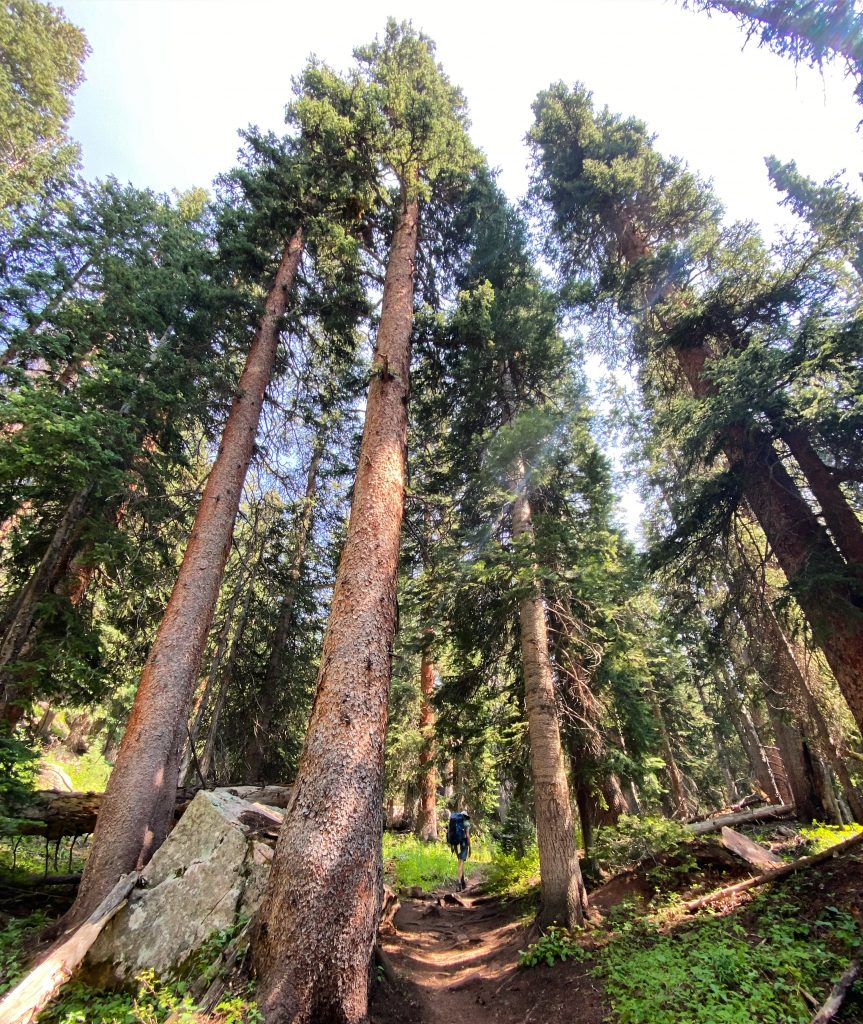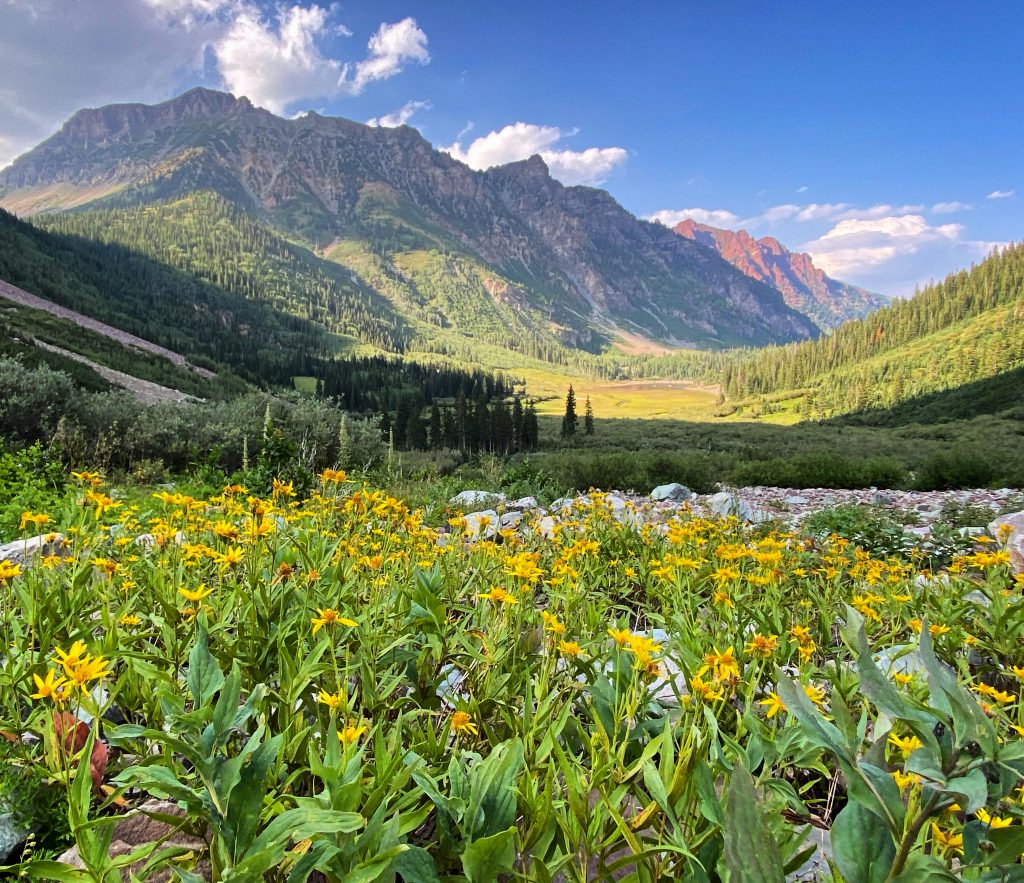A Backpacking Travelogue

Alongside the ongoing weight of the global pandemic, another area of distress that is increasingly coming up for people is climate grief as we face fires, hurricanes with greater intensity or frequency or intensity, as well as rising waters and flooding. It is easy to feel helpless and a looming existential fear now referred to as “eco-anxiety.”
Even if you haven’t been directly impacted by one of these events, you have likely been exposed to images and stories through the media leading to a form of anticipatory fears or about the potential for additional disasters or the extinction of species and ecosystems such as coral reefs or glaciers. Or maybe, you too have had eerie orange skies at sunset from fires far away. Just like any ongoing stressor, it is important to have strategies to cope with climate grief.
Recently, I had an opportunity to go backpacking on one of my favorite trails here in Colorado. For the second summer in a row, my trips to the hills have been colored by a backdrop of haze and smoke. However, I found some tools that helped me work through my feelings while walking on the trail that I’ll share in this post. My hope is that my own feelings about climate grief might help you know that you are not alone and that my sharing of coping strategies might help you find a path forward.
A Map of Tiny Perfect Things

We camped out near the trailhead and woke up early to begin our hike. I stepped out of the tent to a sky full of smoke which gave an ominous feeling to the start of the trip. Having hiked this trail before, I’m used to focusing on the grandeur of the mountainous horizon but with those views obscured, I set my sights on the tiny perfect things that were all around me. (This phrase comes from a movie I highly recommend called A Map of Tiny Perfect Things.)
The process of looking for the beauty in the midst of a challenge lifted my spirits. I focused on the vibrant flowers, the moths and butterflies, and the 1000s of mushrooms that had popped up after the rainstorms from the previous weeks. I’m not a mushroom expert but suddenly wish I was! I do know not to eat the red ones with the white spots and didn’t want to take any chances so I simply took lots of photos.
By the end of the day I felt fulfilled. Focusing close in when the big picture is hazy, unclear, or frightening is a powerful tool to have. It carried me below a stunning waterfall and up to a beautiful lake. It set my mind at ease.

Letting Go and Let it Be

It wasn’t until I was well into the four-day hike that I realized how much stress I was carrying in my body and mind. Climate grief, the distant forests on fire, the smoky air, accumulated Covid stress, the general state of the world…all of this felt like a massive burden that I was harboring in my heart. My sleep was filled with dreams that left me feeling not quite rested. Simply put, I was processing a lot.
On long hiking days I find it helpful to have a mantra. This Sanskrit word comes from two roots, manas which translates to mind and tra which translates to vehicle. So, a mantra can be thought of as a “mind vehicle” which transports your mind from rumination and worry to a quiet, peaceful state. The words I needed on this day rang through loud and clear…letting go. And with each step up and over the mountain pass, I imagined releasing these accumulated burdens. I handed my worries to the hills. I allowed myself to grieve. The tightness around my heart softened. It was as if my own internal process was a clearing in itself.
That day I climbed up above 12,400 ft. While it was still hazy, I could also feel a tender sprout of hope springing up in my heart where the heaviness had been. This along with the continued mushroom and flower extravaganza kept me moving forward.
Sometimes a mantra evolves. On this day, “letting go” became “let it be.”
“And when the night is cloudy there is still a light that shines on me. Shinin’ til tomorrow, let it be, let it be, let it be…”
~John Lennon
Thank you Trees

On the last few days of the trip the skies were remarkably clearer. The crisp blue skies and defined edges of the mountain skyline brightened my mood. As I hiked, I reflected on all that smoke that had been in the air. Where does it go? In the short term, the winds blow it in and onward to another part of the country or the world. But eventually, we do see a clearing. The trees clean the air. The rain sends it back to earth. The rivers carry it to the oceans.
In the big picture, the fires are needed just as every element is part of earth’s life cycles. There are fire dependent trees, flowers, and species. And, on this day as I walked through the forest I felt a deep sense of appreciation for our planet and the way that fires have their own intelligence. The fires open up the possibility for new growth. And I am filled with a deep gratitude for our natural air purifiers…Thank you trees, thank you clouds, thank you wind, thank you rain, thank you soil, thank you rivers,…

Coping with Climate Grief

Yes, all that smoke is dangerous for us to breathe, especially if you already have a lung condition. And, I am not dismissing the terrible heartache that can come with fire especially when it leads to the loss of your home or in other ways impacts your community. Here in Boulder, Colorado we’ve had our share of losses including experiencing the impact of the 100 year flood which not only impacted my home but the majority of our community. What I remember most from that time was the ways that our neighborhood came together to help each other. We took turns using pumps to remove water and worked together to save precious items from each other’s homes. We lent each other vacuums and fans. We grieved our losses collectively.
This week, as I returned to town after the backpacking adventure, the smoke also returned to our city. Having coping strategies to manage climate grief is important, and we also need to know what we can do to help manage this crisis. For example, we can each do our part to reduce our carbon footprint and we can focus our actions on sustainability by driving less, unplugging electronics when they are not in use, reusing, and recycling. Having spaces to talk with others who feel similarly can help you know that you are not alone. Furthermore, connecting to like-minded people can help you develop climate activism plans.
Spending time in the wilderness always helps me to remember what I love about this planet and why it is worth preserving. Thank you firefighters, thank you scientists who are looking at climate solutions, thank you to all who love and long to care for our earth!
I will close with wise counsel from Thomas Moore,
“The Earth is not a platform for human life. It’s a living being. We’re not on it but part of it. Its health is our health.”
~Thomas Moore
About Dr. Arielle Schwartz

Arielle Schwartz, PhD, is a psychologist, internationally sought-out teacher, yoga instructor, and leading voice in the healing of PTSD and complex trauma. She is the author of five books, including The Complex PTSD Workbook, EMDR Therapy and Somatic Psychology, and The Post Traumatic Growth Guidebook. Dr. Schwartz is an accomplished teacher who guides therapists in the application of EMDR, somatic psychology, parts work therapy, and mindfulness-based interventions for the treatment of trauma and complex PTSD. She has a depth of understanding, passion, kindness, compassion, joy, and a succinct way of speaking about very complex topics. She is the founder of the Center for Resilience Informed Therapy in Boulder, Colorado where she maintains a private practice providing psychotherapy, supervision, and consultation. When not working, you are most likely to find Arielle in nature with her camera combining her love for the outdoors with her passion for photography. Dr. Schwartz believes that that the journey of trauma recovery is an awakening of the spiritual heart.









